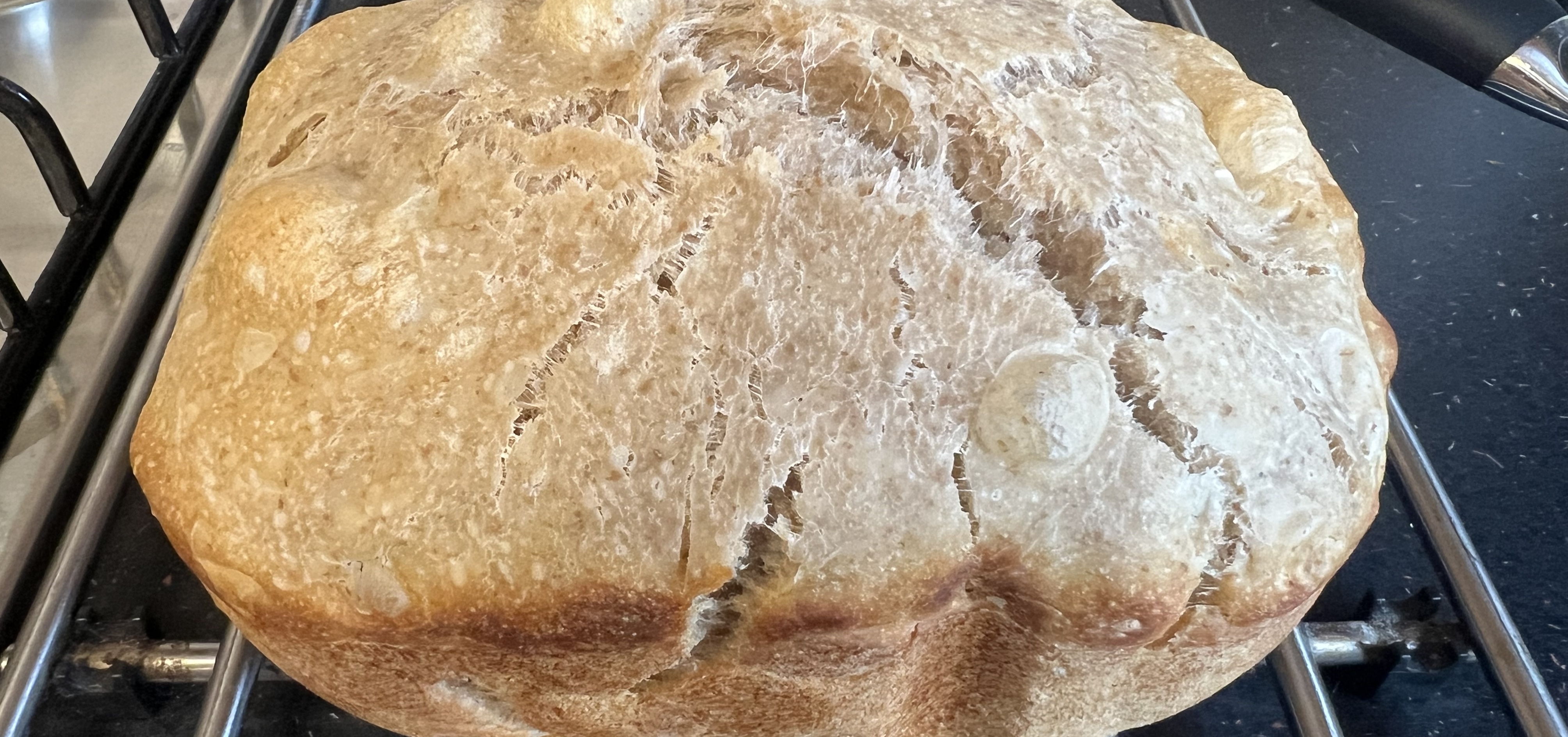Sourdough Bread
Why use sourdough for bread? Well, if you do it my way, it tastes great.
Some people like it hard and crusty — but I just think it always seems like it's already stale and a bit rubbish.
If you follow what I've done, it'll be softer, bubbly, spongy.
Slice it thin for sandwiches.
Slice it a bit thicker for toast — my kids say it's a bit like crumpets. I agree, it's great.
Ingredients
- 100g starter
- 340g water
- 480g strong bread flour
- 9g salt
- 20g sugar
- 15g olive oil OR 15g butter
(If you use butter it'll be stodgier and crustier. If you stick with oil it'll be softer and lighter.)
A handy conversion chart for those who don't speak European:
| Ingredient | Metric (g/ml) | Imperial (oz) | Cups / Spoons (approx.) |
|---|---|---|---|
| Sourdough starter | 100 g | 3.53 oz | ~⅓ cup |
| Water | 340 ml | 11.99 fl oz | ~1 ⅓ cups |
| Strong bread flour | 480 g | 16.93 oz | ~4 cups |
| Salt | 9 g | 0.32 oz | ~1½ tsp |
| Sugar | 20 g | 0.71 oz | ~1½ tbsp |
| Olive oil or butter | 15 g | 0.53 oz | ~1 tbsp |
No-BS Breadmaker Sourdough Bread
Let's pretend you're using my breadmaker, just because it's quicker and easier.
(At some point I will add a more traditional recipe using a normal oven).
- Get the breadmaker bucket and fit the mixing blade.
- In this order, put in all the ingredients: water, starter, flour, salt, sugar, oil.
- Set cycle 20 (or whatever your machine does for pizza dough). When it's done mixing, take it out of the machine.
Note: Don't wait for the resting phase. It won't ruin it, but it's better if you don't. - Get your bowl, pour in a drizzle of oil, and spread it about with your hands. Coat the inside.
- With greasy/wet hands (otherwise it's going to stick to you like wet poop), grab your dough, lift it out of the bucket, and put it in the bowl.
Don't forget to fish out the mixing blade if, like mine, it comes out buried in the dough. - Put the bowl on your kitchen counter, lay a damp tea towel over the top to stop the dough drying out, and go away.
- Half an hour later, come back. It's time to stretch and fold. Wet your hands again (it's still sticky as hell), grab the side and lift it. Stretch the dough, then fold it over.
- Turn the bowl a quarter turn and do it again. Repeat until you've done all four sides, then re-cover it and go away again.
- Half an hour later come back again, and stretch and fold it just like last time. Re-cover, and go away again. Honestly, most of this process is you going away to let the magic happen.
- Now you have a choice. If you enjoyed stretching and folding, you can do it again in half an hour and then again in an hour. If not and you've got stuff to do, move on to the next step.
- Give it 4–8 hours on the side, or put it in the fridge overnight.
If you fridge it, cover it with cling film. If you leave it out, the damp tea towel is fine.
If you fridged it, you can leave it out to warm up before baking, or chuck it in cold. It'll affect consistency, but honestly, you need to try it both ways to see what you like.
If you didn't fridge it, it's still yesterday, so yay whatever, move on to the next step. - Get your cleaned breadmaker bucket, do NOT fit the mixing blade, pour in a splash of olive oil and swirl it around like you did with the bowl, then transfer the dough into it.
- In my machine, we do a plain bake (cycle 14) and whack the timer up to 65 minutes, if you've used the quantities I gave you.
- If you've got a food thermometer, you can rest assured it won't have a raw bit in the middle if, at the end of baking, you jab in the probe and get over 93°C. 95°C is ideal.
- Drop the loaf out of the bucket and leave it on a rack to cool. DO NOT CUT IT FOR AN HOUR OR YOU'LL SCREW IT UP.
- After an hour you can start slicing it to eat/use it, or you can wrap it up. It'll slowly go stale, but be edible for 2–3 days.
You now have real bread. Congratulations.
